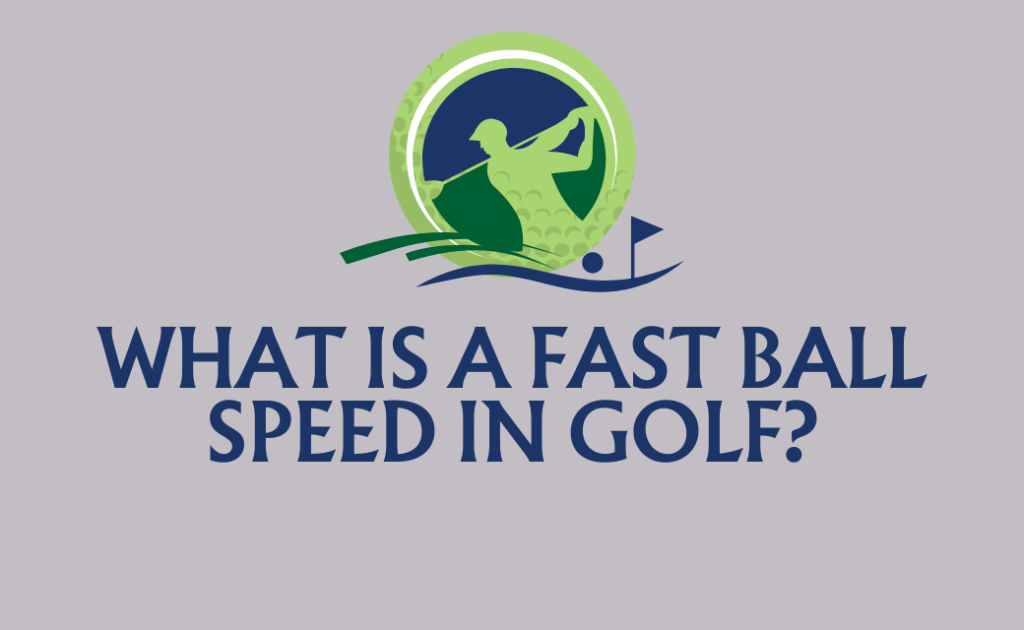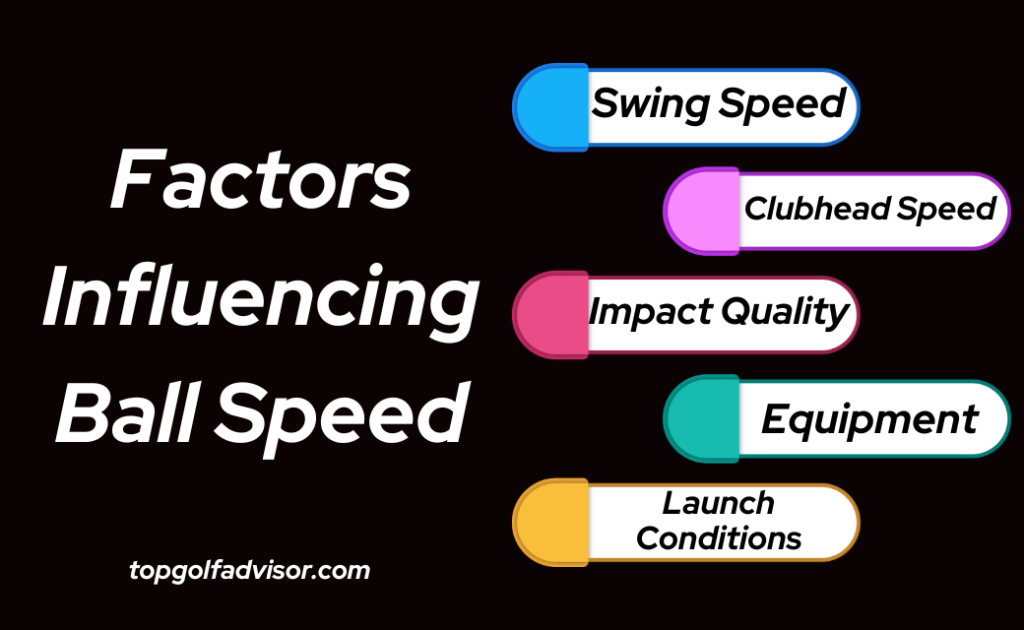What is a fast ball speed in golf? And why do you need it? Fast ball speed is often synonymous with powerful drives and enhanced performance. In this guide, we are going to discuss what makes a fast ball speed in golf, the factors influencing it, and how it can impact your overall game.

What Is A Fast Ball Speed In Golf?
So, grab your gear, and let’s get into today’s blog.
Defining Ball Speed in Golf
Ball speed is a critical metric in golf that measures the velocity of the golf ball immediately after impact with the clubface. It is a critical component in determining the distance a shot will cover, especially off the tee. Expressed in miles per hour (mph) or kilometers per hour (km/h), ball speed is influenced by various factors, making it a dynamic and multifaceted element of the game.
The Equation of Distance: Ball Speed and Launch Angle
The distance a golf ball travels is intricately linked to both ball speed and launch angle. Achieving an optimal combination of these two factors can result in longer, more powerful shots. The relationship between ball speed and launch angle can be understood through the following equation:
Distance=Ball Speed×Launch Angle×Deceleration Factor
Distance=Ball Speed×Launch Angle×Deceleration Factor
While ball speed is crucial, the launch angle—dictated by factors such as clubface angle, loft, and the impact point on the clubface—plays a pivotal role in determining the trajectory and overall distance of the shot.
What Constitutes a Fast Ball Speed?
The definition of a fastball speed can vary based on factors such as the player’s skill level, age, and gender. However, in general terms, a ball speed exceeding 160 mph is considered fast and is often associated with professional golfers and long-drive specialists. For amateur and recreational golfers, achieving ball speeds above 140 mph can be considered impressive.
Factors Influencing Ball Speed
What is a fast ball speed in golf? Well, several factors contribute to the generation of fast ball speed. Therefore, understanding these elements can aid golfers in optimizing their swing mechanics and equipment choices to unlock more incredible velocity.
Swing Speed:
The Power Source: The speed at which a golfer swings the club is a primary determinant of ball speed. A faster swing typically translates to higher ball speed.
Clubhead Speed:
Efficient Transfer of Energy: The speed of the clubhead at the point of impact directly affects ball speed. Golfers can enhance clubhead speed through proper swing mechanics and equipment choices.
Impact Quality:
Centered Strikes: The location on the clubface where the ball makes contact influences the efficiency of energy transfer. Shots struck at the sweet spot result in more energy being transferred to the ball, contributing to increased speed.
Equipment:
Technology Matters: The choice of golf clubs, particularly the driver, can impact ball speed. Modern driver technology, including materials and design innovations, can contribute to higher ball speeds.
Launch Conditions:
Optimal Trajectory: Achieving the right launch conditions, including a favorable launch angle and low spin, can maximize ball speed and overall distance.

The Impact of Club Selection on Ball Speed
While various clubs contribute to a golfer’s overall performance, the driver is often the focal point for maximizing ball speed. The design and technology incorporated into modern drivers aim to enhance clubhead speed, optimize launch conditions, and unlock greater distance. Here’s how club selection can influence ball speed:
Driver Technology:
Larger Clubheads: Modern drivers feature larger clubheads with enhanced aerodynamics, promoting higher clubhead speeds.
Adjustable Features: Drivers often come with adjustable features, allowing golfers to
fine-tune loft, face angle, and weight distribution to optimize launch conditions.
Woods and Irons:
Consistency Across Clubs: While the driver is critical for maximum distance, advancements in technology have also influenced fairway woods and irons, providing consistency in ball speed across the entire set.
Custom Fitting:
Tailored to Your Swing: Professional club fitting considers a golfer’s swing characteristics, allowing for the selection of clubs that optimize ball speed based on individual preferences and tendencies.
The Importance of Consistency in Ball Speed
Consistency in ball speed is a crucial element for golfers seeking reliable and repeatable performance on the course. While hitting the occasional high-speed shot is exciting, achieving consistency across a series of shots is essential for optimizing overall distance and accuracy.
Repeatability of Swing Mechanics:
Consistent Form: Developing and maintaining consistent swing mechanics contributes to repeatability, allowing golfers to generate reliable ball speeds.
Equipment Fit and Feel:
Comfort and Confidence: Golfers who are confident in their equipment choices and feel comfortable with their clubs are more likely to achieve consistency in ball speed.
Practice and Feedback:
Focused Training: Regular practice sessions, coupled with feedback on swing mechanics and impact quality, contribute to the development of a consistent and powerful swing.
Improving Ball Speed: Tips and Techniques
For golfers looking to enhance their ball speed, here are some tips and techniques to consider:
Optimize Your Swing Mechanics:
Seek Professional Instruction: Working with a golf instructor can help identify and address swing flaws that may hinder ball speed.
Focus on Efficiency: Emphasize efficient energy transfer from the body to the clubhead, minimizing wasted motion.
Strength and Flexibility Training:
Target Core Muscles: Strengthening core muscles enhances overall body rotation, contributing to increased clubhead speed.
Maintain Flexibility: A flexible body allows for a more dynamic and powerful golf swing.
Club Fitting:
Consult a Professional: Consider a professional club fitting to ensure that your equipment is tailored to your swing characteristics.
Explore Adjustability Features: Experiment with adjustable features on modern clubs to find settings that optimize launch conditions and ball speed.
Focus on Impact Quality:
Sweet Spot Strikes: Practice consistently striking the sweet spot on the clubface to maximize energy transfer to the ball.
Use Impact Tape: Utilize impact tape during practice sessions to gain visual feedback on the location of clubface contact.
How Does Golf Ball Speed Change By Impact Location?
The forgiveness offered by modern golf clubs for off-center shots is excellent. But even with cutting-edge technology, there’s always a cost associated with missing the center of gravity or the sweet spot. I’ll give you a few examples using my clubs to show you how your ball speed can be affected by strike location (as well as a few other critical distance characteristics).
How Do I Increase My Golf Speed?
We think most of you can improve your ball speed (and distance) in two ways:
- Boost your impact inclinations
- Make your body move more quickly.
As I’ve said many times before, during practice all golfers should be focusing on their impact patterns. Adding this level of focus to your current practice regimen is not hard. It is the least complicated way to increase ball speed.
There’s more work involved in the second option than just hitting balls. If everything else is equal, you will see a rise in ball speed if you work out to raise your clubhead speed. But I suggest you do it correctly. Trying to swing harder will likely lead to a technique breakdown, which will decrease the speed of the ball and affect your impact spot. Sometimes when you hit golf balls fast they travel in curves. Check out our article on Why Does My Golf Ball Curve Left
Impact Location Training:
Fortunately, determining your strike placement is not too difficult. Purchase a can of foot odor eliminator, and while you practice, begin observing your patterns.
Training with impact location can be fun for two reasons:
- It provides more marvelous structure and meaning to your practice sessions.
- By concentrating on the impact, you free up your swing to self-organize a fix without having to consider every single moving component that went into getting there.
Many players are surprised at how much progress they can make after they identify their impact habits and deliberately try to start striking different places of the face.
You can also make adjustments to your setup, like moving closer or farther away from the ball, to see how it affects where you strike the ball.
Changing the Tee height is another experiment that I enjoy doing. Start experimenting with your tee’s low, medium, and high settings to observe how your impact spot on the driver’s face (or other clubs you play off the tee) changes. Your objective is to try and move the strike more toward the center or slightly above it and less near the bottom of the clubface.
Training Your Body To Hit Faster:
There are a few strategies to improve your clubhead speed without jeopardizing your technique if you’re into physical conditioning; this will help you enhance the speed of the golf ball.
The best approach is to workout many times a week with an emphasis on strength, mobility, and power. There are many helpful golf-specific programs available. Locating a trainer whose TPI qualifies is one suggestion.
Overspeed training has also gained popularity as a means of accelerating clubhead speed. In the golf business, SuperSpeed Golf has emerged as the benchmark for speed training. You can do this on its own or in addition to your exercise regimen.
Wrapping It Up!
The most important thing to remember if you aim to hit golf strokes as far as possible is your ball speed. Consider it an indicator of effectiveness.
As an easy (and helpful) part of your practice sessions, we advise you to focus on honing your impact location as it can help you understand what is a fast ball speed in golf.
Additionally, you can improve your swing speed by physically training yourself to do so. When you combine the two, you’ll soon be blowing your friends’ drives!
FAQs
What is the average ball speed for a man golfer?
The typical ball speeds for male professionals using their driver are as follows, from HankHaney.com: 161 mph for Scratch or Better. 5 HCP: 147 miles per hour. 10 HCP equals 138 mph.
What swing speed do you need to hit 300 yards?
Driving optimization’s standard rule of thumb states that golfers add 2.75 yards of distance for each mile per hour of clubhead speed they generate (via carry and roll). Therefore, a clubhead speed of about 109 mph is needed to strike a ball 300 yards under typical circumstances.
What is my swing speed if my ball speed is 150?
On driver strokes, a golfer would aim for a smash factor of almost 1.50. This implies that the ball would travel 150 mph with a club speed of 100 mph.
